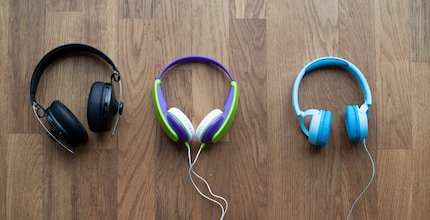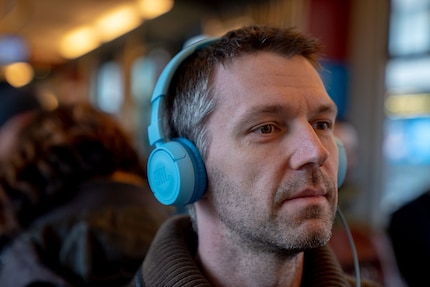

Children's headphones: what's in it for them and how much do they cost?
Do children's headphones serve any purpose? How do they differ from adult headphones? I'd like to give you an overview of this type of headphone, which I hadn't seen before.
Thomas Wüthrich, our Marketing Manager for audio products, explained to me that children's headphones were a niche in their own right. I remember well that my fellow editor Livia tested the charming unicorn headphones, but I didn't know that we had dozens of children's headphones in shop.
I imagine that when your child listens to the same Kasperli story for the millionth time and can't seem to get enough of it, it's not them, but you who are thinking about buying headphones.
As I don't have any children of my own, I asked our editor, Aurel Stevens, to confirm my hunch. After all, her five-and-a-half-year-old daughter listens to the same things all the time, and they're audiobooks with the characters' voices getting on her nerves.
Imagine you want to preserve your sanity. Why not just get some adult headphones? In other words, what's the difference between children's headphones and adult headphones? To answer that question, I've selected these two products from our shop.
Difference #1: size
Nothing but adults, not all headphones fit all heads. The HP Omen Mindframe was far too big for our tester Kevin.
This is even truer for children. Most headphones have a headband. This is adjustable, but the possible adjustment is of course limited. JVC indicates a minimum age of three for its headphones.
This is even more true for children.
There is no maximum age according to the manufacturers, and indeed even an adult can wear these two children's models. They're noticeably smaller than my Sennheiser Momentum 2, for example, but the circumference adjustment is quite generous.

I find the JVC HA-KD5 very uncomfortable, not because of the size, but because it's made entirely of hard plastic with the exception of the earpads. The JBL Junior JR300, on the other hand, is padded even around the headband. What's more, the earcups swivel. This headset therefore adapts better to the shape of the head and can be stored without taking up too much space.
Difference #2: the design
When I say that these headphones are for nursery and primary school, I'm thinking mainly of the design. I imagine they won't appeal to older children. In my eyes, the purple and neon green of the JVC model clash horribly. The other variants, such as the light yellow-blue or pink-purple, are also scarily beautiful. But I'm well aware that I'm not part of the target audience. I guess it appeals to children: [[quote: Great headphones for kids, my daughters love them. "Paplito60"]]
The light blue JBL, which of course also comes in pink, is almost discreet compared to the garish colours of the JVC. On the tram, I almost go unnoticed.

Both headphones come with very similar stickers that will allow your children to personalise their new acquisition. The letters on the JVC seem to me to be more pedagogically interesting than the brand logos on the JBL.

Difference #3: volume limitation
According to the manufacturers, both models are limited to 85dB. This is supposed to protect the sensitive ears of younger children. However, this article (in German) on the significance of noise in children states that babies' cries can reach 120 decibels. That's very high. Are children's ears really more sensitive?
A paedo-audiologist explained to me that the shorter ear canal in children plays a role. The shorter the canal, the louder the sound that passes from the ear entrance to the eardrum. The eardrum is therefore put under greater strain in small children. It should also be noted that with earphones, the source of noise is directly on the ear, or even in the ear in the case of in-ear earphones (yes, there are also some specially designed for children). Limiting the volume is therefore sensible.
I noticed during my test, however, that the volume is not really limited to 85 dB. The protection simply reduces the sound level. A source with a very low sound level can therefore be inaudible, even when the volume is set to maximum. On the other hand, with my stereo system, I can push the children's headphones up to dangerous levels. My system isn't even particularly powerful. The 85dB limit is therefore only valid for mobile devices whose output volume is limited anyway.
The product sheet on the JVC website says: "*The maximum sound volume of 85 dB may be exceeded if the signal source has a very high sound level."This is only mentioned in small print, whereas "volume limiter" is written very large on the packaging. JBL doesn't even specify that the maximum value can be exceeded.
Difference #4: prices
On average, children's headphones are much cheaper than adult models. This is probably because children break them even more often than adults. At least, that's what parents think. Or at least that's what manufacturers think parents think. Besides, I get the impression that the JVC is more robust.
On the other hand, the sound quality of the JBL seems much better to me. For the price, both are acceptable, although nowhere near the quality of adult headphones. It's the world upside down when you think kids hear better.
Difference #5: the cords
The cords are very short: 80 cm for the JVC and 1 metre for the JBL. This is supposedly a suitable length for children, although I can't quite see the logic. Perhaps the manufacturers are embellishing a measure to reduce production costs. The problem is easily solved by ordering an extension when you buy it or by taking the Bluetooth version.

Value Stereo jack extension cable
2 m, 3.5mm jack (AUX)

Conclusion: don't leave your children to their own devices
The existence of headphones for children is justified and their reduced size is a good thing. Protecting children's more fragile ears is also an argument, but beware: the volume limiter is only effective with mobile players. With powerful stereo systems, don't leave your children to fend for themselves in the belief that headphones will protect their eardrums. This is a point that manufacturers should make much clearer.
My interest in IT and writing landed me in tech journalism early on (2000). I want to know how we can use technology without being used. Outside of the office, I’m a keen musician who makes up for lacking talent with excessive enthusiasm.
These articles might also interest you

Product test
Trying to fall into a deep sleep, but someone’s snoring? These Soundcore Sleep A30 earbuds can make it happen
by Siri Schubert

Product test
Philips open-ear sports headphones: affordable, but not a top model
by Siri Schubert

Product test
Nothing Headphone (1) review: a great-sounding fidget toy
by Jan Johannsen

